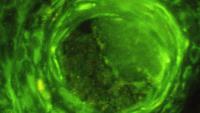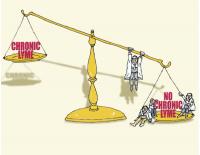Chronic Symptoms

Chronic Lyme Disease vs Post-Treatment Lyme Disease Syndrome
Patients typically use the term chronic Lyme disease to describe the cluster of symptoms that started after getting Lyme disease and that persist despite having received a course of antibiotic treatment which has been deemed curative by the Infectious Diseases Society of America. Patients say, "I'm not cured. I have symptoms now that I never had before Lyme disease. I'm fatigued 90% of the day. My muscles ache. My brain is in a fog. I can't think clearly any more. I'm super sensitive to light and sound. What is going on? Chronic Lyme disease does exist - I'm a living example of it!"
If a patient is treated early at the time of the erythema migrans rash, then the risk of getting chronic symptoms is much lower; most people recover fully. Although the infectious disease community dislikes the term chronic Lyme disease because to them it implies that chronic infection is the known cause, the medical community is quite comfortable with what they see as a more "etiologically neutral" term: Post-treatment Lyme Disease Syndrome (PTLDS). The word "syndrome" means that there might be many different causes of the post-treatment symptoms; these causes might include persistent infection, persistent immune activation, damage from the prior infection, or changes in the brain chemistry that leads to abnormally activated pain or mood pathways or altered cognition. The medical community acknowledges that approximately 5-20% of patients may have chronic symptoms after getting Lyme disease, often ones that are quite disabling .
Whatever one calls it, the experience is the same. Most often these patients experience profound fatigue, pain, and/or cognitive impairment. Mild to moderate levels of depression and anxiety may also accompany these symptoms, as the functional limitations can lead to social isolation, inability to work, and loss of sense of one's identity as a provider, caretaker, or friend. Sometimes patients find themselves identifying with Job - the just and good man in the Bible whose life was wrecked by illness, death of loved ones, and economic disaster; he felt tormented by God.
The Experience of Lyme Disease
In our book, Conquering Lyme Disease: Science Bridges the Great Divide, we review several of the key features of Lyme disease that can make the experience of this illness so challenging, including:
- The politically charged climate
- The protean nature of manifestations of the illness
- The waxing and waning course of symptoms
- The psychological ramifications of having an "invisible" chronic illness and the experience of invalidation
- The challenge of having a disease that affects the brain and sensory system
- The impact of uncertainty surrounding diagnosis, treatment, and prognosis
"The experience of the patient with chronic or relapsing and remitting symptoms after antibiotic treatment for Lyme disease is often one of confusion and profound disorientation. Invisible symptoms mean that others cannot tell how it feels inside. Waxing and waning symptoms make it impossible to plan. Medical controversy means that individuals may find themselves at odds with a previously trusted physician. The lack of a clear social consensus regarding the illness means that even friends may view them with skepticism and doubt. Families may be pulled apart and suffer severe financial setbacks, either due to lost earning power or to extensive medical expenses. Uncertainty and doubt may exist in the patient him/herself, at a loss as to whether to ‘push through it,’ see yet another healthcare provider, or resign themselves to more or less permanent lifestyle changes. Like Job, they are assailed from within and without, feeling that the powers-that-be have left them in the lurch, friends doubt them, and all their good efforts have come to naught." (From Conquering Lyme Disease, 2018)
